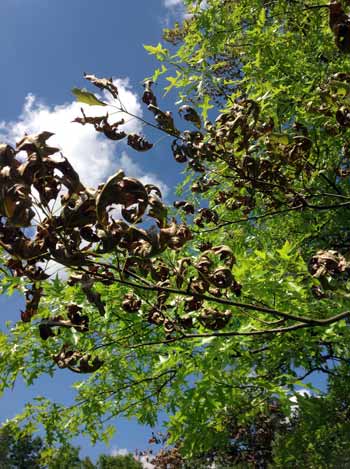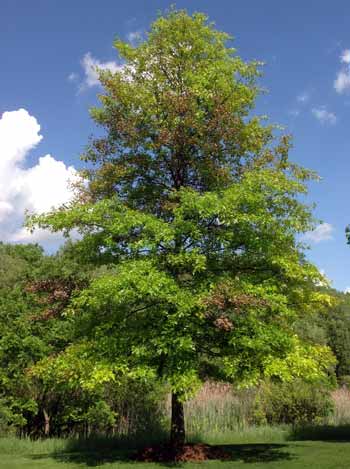“Burning” of oak leaves associated with trunk injection
Fall application can reduce risk of injury to oak trees.
As we noted in the recent Michigan State University Extension article “Severe chlorosis in pin oaks,” chlorosis in pin oaks has been especially severe this summer. Trees of other species are also showing poor color due to the cool, wet weather we experienced this spring. Chlorosis associated with specific nutrients such as iron or manganese can effectively be treated with trunk injection treatments. In the case of pin oaks, chlorosis may be treated with injections of iron chelates or ferric ammonium citrate (FAC).
Arborists and homeowners should be aware that FAC injections can burn leaves, especially when applied in late spring or early summer. Several photos recently submitted to MSU Diagnostics Services serve to illustrate this point. The trees were injected with FAC in early June and within three days, leaves in several sections of the tree were severely scorched.


Left, Leaf scorch on pin oak became apparent within three days of trunk injection with iron.
Right, Leaf scorch patterns following trunk injection reflect sectored movement of water within the trunk of the tree.
Photo credits: Jackie Smith, MSU Diagnostics Services
MSU campus arborist Paul Swartz has extensive experience with trunk injections and suggests that scorch can be reduced by injecting trees in the fall when water movement is generally slower, allowing more time for product to diffuse in the trunk. Soil applications of iron can also reduce risk of scorch, but usually take longer to show results. It is important to note that while severely scorched leaves will not recover, the overall effect on the tree is temporary.
Dr. Cregg's work is funded in part by MSU's AgBioResearch.



 Print
Print Email
Email